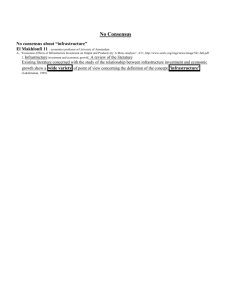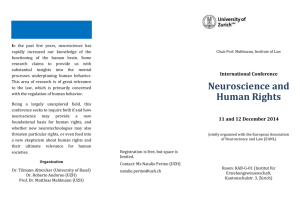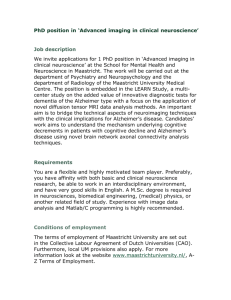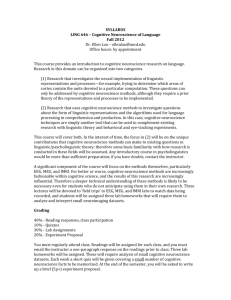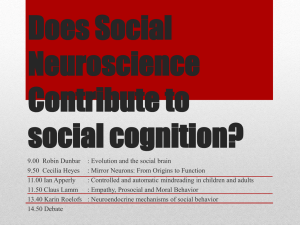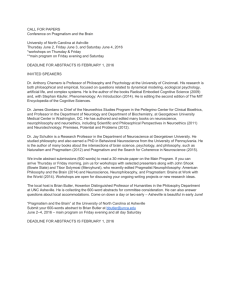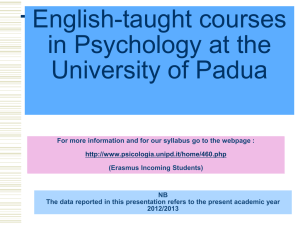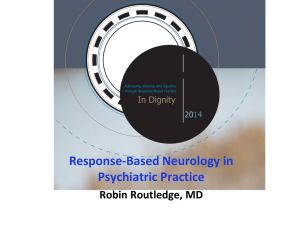refs_cocuzza_2014
advertisement
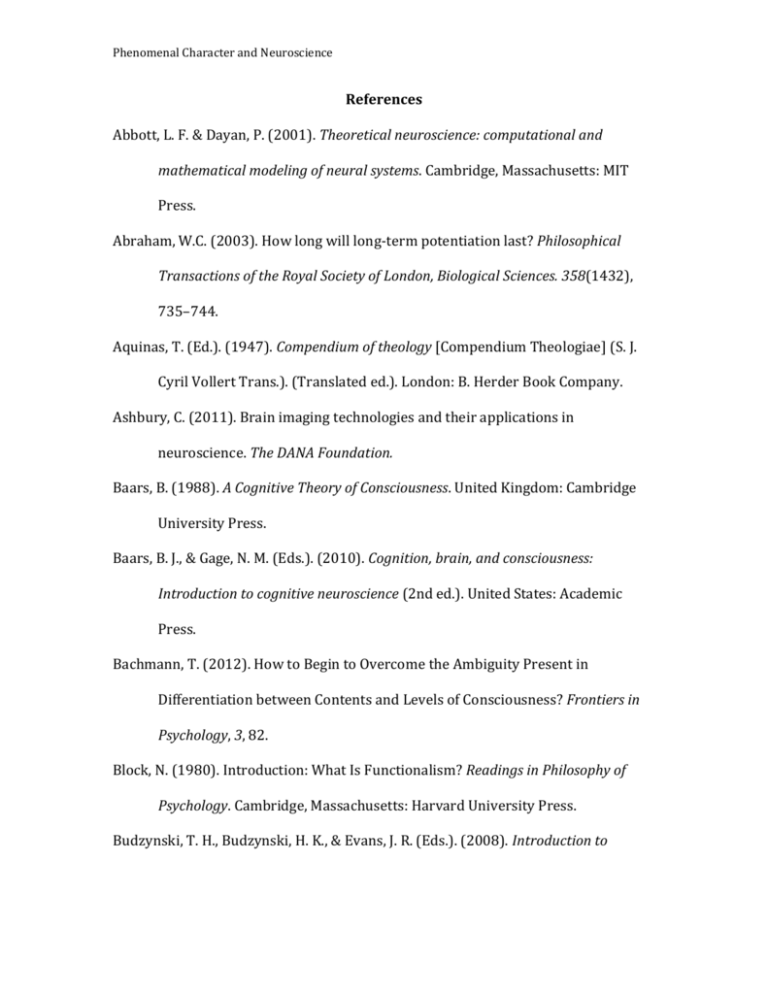
Phenomenal Character and Neuroscience References Abbott, L. F. & Dayan, P. (2001). Theoretical neuroscience: computational and mathematical modeling of neural systems. Cambridge, Massachusetts: MIT Press. Abraham, W.C. (2003). How long will long-term potentiation last? Philosophical Transactions of the Royal Society of London, Biological Sciences. 358(1432), 735–744. Aquinas, T. (Ed.). (1947). Compendium of theology [Compendium Theologiae] (S. J. Cyril Vollert Trans.). (Translated ed.). London: B. Herder Book Company. Ashbury, C. (2011). Brain imaging technologies and their applications in neuroscience. The DANA Foundation. Baars, B. (1988). A Cognitive Theory of Consciousness. United Kingdom: Cambridge University Press. Baars, B. J., & Gage, N. M. (Eds.). (2010). Cognition, brain, and consciousness: Introduction to cognitive neuroscience (2nd ed.). United States: Academic Press. Bachmann, T. (2012). How to Begin to Overcome the Ambiguity Present in Differentiation between Contents and Levels of Consciousness? Frontiers in Psychology, 3, 82. Block, N. (1980). Introduction: What Is Functionalism? Readings in Philosophy of Psychology. Cambridge, Massachusetts: Harvard University Press. Budzynski, T. H., Budzynski, H. K., & Evans, J. R. (Eds.). (2008). Introduction to Phenomenal Character and Neuroscience quantitative EEG and neurofeedback: Advanced theory and applications (2nd ed.). United States: Academic Press. Carlson, N. R. (Ed.). (2012). The physiology of behavior (11th ed.). United States: Pearson. Carpenter, G.A. & Grossberg, S. (2003). Adaptive Resonance Theory, In Michael A. Arbib (Ed.), The Handbook of Brain Theory and Neural Networks, Second Edition (pp. 87-90). Cambridge, Massachusetts: MIT Press. Carter, M., Shieh, J.C. (2010). Guide to Research Techniques in Neuroscience. New York: Academic Press. Chalmers, D. J. (1995). Absent qualia, fading qualia, dancing qualia. Conscious experience. T. Metzinger. Ed. Paderborn, Ferdinand-Schoningh. Chalmers, D. J. (1995). Facing up to the problem of consciousness. Journal of Consciousness Studies, 2(3), 200-219. Churchland, P.S., Koch, C., & Sejnowski, T.J. (1993). What is computational neuroscience? Computational Neuroscience, MIT Press. 46-55. Crick, F. H. (1958). On protein synthesis. Symposia of the Society for Experimental Biology 12: 138–163. Cristancho, M. (2012). Atypical Depression in the 21st Century: Diagnostic and Treatment Issues. Psychiatric Times. Crossman, E. K. (1985). The kiss and the promise: A review of Hubert L. Dreyfus’ What Computers Can’t Do: The Limits of Artificial Intelligence. Journal of the Experimental Analysis of Behavior, 44(2), 271–277. Darby, D., & Walsh, K. (Eds.). (2005). Neuropsychology: A clinical approach (5th ed.). Phenomenal Character and Neuroscience United States: Churchill Livingstone. Dennis, T. A., & Hajcak, G. (2009). The late positive potential: a neurophysiological marker for emotion regulation in children. Journal of Child Psychology and Psychiatry, and Allied Disciplines, 50(11), 1373–1383. Doidge, N. (2007). The Brain That Changes Itself. United States: Viking Press. Dreyfus, H. (1965). Alchemy and artificial intelligence. California: The RAND Corporation. Edelman, G.M. (1993). Neural Darwinism: Selection and reentrant signaling in higher brain function. Neuron, 10(2), 115-125. Engel, A. K., Fries, P., Konig, P., & Singer, W. (1999). Temporal binding, binocular rivalry, and consciousness. Conscious Cognition, 8(2), 128-151. Fodor, J.A. (1983). The Modularity of Mind. United States: MIT Press. Forrest, D. W. (1995). Francis Galton. Seven Pioneers of Psychology. London and New York: Routledge. Gray, J. (2003). How are qualia coupled to functions? Trends in Cognitive Sciences, 7(5), 192-294. Goldberg, T. E., & Weinberger, D. R. (Eds.). (2009). The genetics of cognitive neuroscience (1st ed.). United States: MIT Press. Grossberg, S. (1999). The link between brain learning, attention, and consciousness. Consciousness and Cognition, 8(1), 1-44. Hebb, D. O. (2002). The organization of behavior: A neuropsychological theory (New Ed ed.). United States: Psychology Press. Heidegger, M. (2008). Being and time [Sein und Zeit] (J. Macquarrie, E. Robinson Phenomenal Character and Neuroscience Trans.). (Reprint ed.). United States: Harper Perennial Modern Classics. Hegel, G. W. F. (Ed.). (1977). Phenomenology of spirit [Phänomenologie des Geistes] (A. V. Miller Trans.). (New Ed ed.). United Kingdom: Oxford University Press. Hurley, S. & Noë, A. (2003) Neural plasticity and consciousness. Biol. Philos., 18, 131– 168. Husserl, E. (1983). Ideas pertaining to a pure phenomenology and to phenomenological philosophy [Ideen zu einer reinen phänomenologie und phänomenologischen philosophie] (F. Kersten Trans.). (Reprint ed.). United States: Martinus Nijhoff Publishers. Husserl, E. (Ed.). (2001). Logical investigations, volume 1 (D. Moran Trans.). (Abridged, Reprinted, Revised ed.) Psychology Press. Kant, I. (Ed.). (1999). Critique of pure reason [Kritik der reinen Vernunft] (P. Guyer, A Wood Trans.). (Reprint ed.). United States: Cambridge University Press. Keeley, B. L. (2009). The early history of the quale and its relation to the senses. In John Symons, & Paco Calvo (Eds.), The routledge companion to philosophy of psychology () Routledge. Lambert, J. H., & Arndt, H. W. (1965). New organon [Neues Organon: Volume 2 of Philosophische Schriften] (Georg Olms Trans.). (Translated ed.). United States: Indiana University. Lemieux, L., Salek-Haddadi, A., & Josephs, O. ( 2001). Event-related fMRI with simultaneous and continuous EEG: description of the method and initial case report. NeuroImage 14(3), 780–787. Levine, J. (1983). Materialism and qualia: The explanatory gap. Pacific Philosophical Phenomenal Character and Neuroscience Quarterly, 64, 354-361. Lewis, C.I. (1956). Mind and the World Order: Outline of a Theory of Knowledge, New York: Charles Scribners. Reprinted by Dover Publications. Lømo, T. (2003). The discovery of long-term potentiation. Philosophical Transactions of the Royal Society of London, Biological Series. 358(1432), 617–620. Luck, S. J. (2005). An introduction to the event-related potential technique (cognitive neuroscience) (1st ed.). United States: MIT Press. Lynch, M. A. (2004). Long-term potentiation and memory. American Psychological Association, Physiological Reviews, 84(1), 87-136. Malenka, R., Bear, M. (2004). LTP and LTD: an embarrassment of riches. Neuron, 44(1), 5–21. Merleau-Ponty, M., Smith, C. (Trans.). (1962). Phenomenology of Perception. London: Routledge. Mueller, S., Chao, L., Berman, B., & Weiner, M. (2011). Evidence for functional specialization of hippocampal subfields detected by MR subfield volumetry on high resolution images at 4T. NeuroImage, 56(3), 851–857. Nature Neuroscience. (2013). Focus on neurotechniques. Nature Neuroscience, 16(7), 771. Nagel, T. (1995). Qualia. The Oxford companion to philosophy. T. Honderich. Ed. Oxford, Oxford University Press: 736. Neuper, C., & Pfurtscheller, G. (2010). Neurofeedback training for BCI control. BrainComputer-Interfaces Frontiers Collection, 65-78. Noë, A. & Hurley, S. (2003). The deferential brain in action: Response to Jeffrey Gray. Phenomenal Character and Neuroscience Trends in Cognitive Sciences, 7(5), 195-196. Pascual-Leone, A., Freitas, C., Oberman, L., Horvath, J. C., Halko, M., Eldaief, M., et al. (2011). Characterizing brain cortical plasticity and network dynamics across the age-span in health and disease with TMS-EEG and TMS-fMRI. Brain Topography, 24: 302-315. Pedroso de Moraes, H. Embodiment in cognitive linguistic: from experientialism to computational neuroscience. DELTA [online]. 2010, vol.26 Petitot, J., Varela, F. J., Pachoud, B., & Roy, J. M. (Eds.). (1999). Naturalizing phenomenology: Issues in contemporary phenomenology and cognitive science. United States: Stanford University Press. Petrov, V. (2011). "Chapter VI: Process ontology in the context of applied philosophy". In Vesselin Petrov, ed. Ontological Landscapes: Recent Thought on Conceptual Interfaces Between Science and Philosophy. Popper, K. (1935). The Logic of Scientific Discovery. Vienne, Austria: Verlan von Julius Springer. Reiners, G.M. (2012). Understanding the Differences between Husserl’s (Descriptive) and Heidegger’s (Interpretive) Phenomenological Research. Nursing and Care 1(5), 1-3. Revonsuo, A.; Newman, J. (1999). Binding and consciousness. Conscious Cogn, 8(2), 123–7. Searle, J. (1990). Is the brain a digital computer? Proceedings and Addresses of the American Philosophical Association, 64, 21–37. Searle, J. R. (1998). How to study consciousness scientifically. Consciousness and Phenomenal Character and Neuroscience human identity. J. Cornwell. Ed. New York, Oxford University Press: 21-37. Shadlen M.N., Movshon J.A. (1999). Synchrony unbound: a critical evaluation of the temporal binding hypothesis. Neuron 24(1), 67–77: 111–25. Shonkoff, J. P., & Phillips, D. A. (Eds.). (2000). From neurons to neighborhoods : The science of early childhood development (1st ed.). United States: The National Academic Press. Siegelmann, H.T. & Sontag, E.D. (1994). Analog computation via neural networks. Theoretical Computer Science, 131(20), 331–360. Smythies, J.R. (1994). The walls of Plato's cave: the science and philosophy of brain, consciousness, and perception. United States: Avebury. Stoljar, D. (2009). Edward N. Zalta (ed.). Physicalism. The Stanford Encyclopedia of Philosophy. Straus, E. W. (1964). Phenomenology pure and applied. United States: Duquesne University Press. The White House, Office of the Press Secretary. (2013). Fact Sheet: BRAIN Initiative [Press release]. Retrieved from http://www.whitehouse.gov/the-pressoffice/2013/04/02/fact-sheet-brain-initiative Turner, E. (1969). Hippocampus and Memory. The Lancet, 294(7630), 1123-1126. Varela, F. J. (1996). Neurophenomenology: A methodological remedy for the hard problem. Journal of Consciousness Studies, 3(4), 330-349. Velmans, M., & Schneider, S. (Eds.). (2007). The blackwell companion of consciousness (1st ed.) Blackwell Publishing. von Herrmann, F.W., Maly, K. (Trans.) (2013). Hermeneutics and Reflection: Phenomenal Character and Neuroscience Heidegger and Husserl on the Concept of Phenomenology. Canada: Toronto University Press. Wilson, M. (2002). Six views of embodied cognition. Psychonomic Bulletin and Review, 9(4), 625-636.
